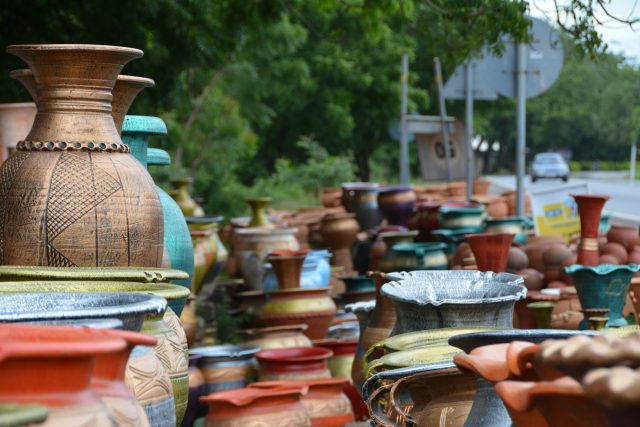In a bustling marketplace beneath the sprawling African sky, the air hums with vibrant colors and intricate designs, each craft telling a story of heritage, skill, and cultural identity. From the rhythmic beats of traditional drums to the delicate beadwork that catches the sun, African crafts are a tapestry woven with history and artistry. As global tourism surges and travelers seek more authentic experiences, a question arises: should tourists be encouraged to purchase these unique crafts? This inquiry delves beyond mere economics, touching upon cultural preservation, ethical consumerism, and the empowerment of local artisans. In exploring this topic, we navigate a complex landscape where tradition meets modernity, and where the simple act of buying a souvenir can have profound implications. Join us as we unravel the threads of this debate, examining the potential benefits and challenges of promoting African crafts to the world’s wanderers.
Cultural Significance and Economic Impact of African Crafts
African crafts are not merely objects of beauty; they are vibrant narratives of cultural heritage and identity. Each piece, whether a woven basket or a carved figurine, tells a story of the community it originates from. These crafts are imbued with symbolism and tradition, often reflecting the beliefs, history, and environment of their creators. By purchasing these items, tourists engage in a form of cultural exchange, gaining insight into the rich tapestry of African life and supporting the preservation of ancient techniques and art forms.
Beyond their cultural importance, African crafts significantly contribute to local economies. The sale of these goods provides artisans with a vital source of income, empowering communities and fostering sustainable development. Encouraging the purchase of these crafts can lead to numerous positive outcomes, such as:
- Job Creation: Generating employment opportunities for skilled artisans and support staff.
- Community Development: Investing in local infrastructure and social services through increased economic activity.
- Global Market Integration: Expanding the reach of African crafts into international markets, enhancing visibility and demand.
As such, the impact of buying African crafts extends beyond the individual transaction, contributing to the broader socio-economic fabric of the continent.

Empowering Artisans Through Ethical Consumerism
In the vibrant markets across Africa, each handcrafted piece tells a story of culture, tradition, and artistry. Ethical consumerism plays a pivotal role in empowering these skilled artisans by encouraging tourists to purchase authentic African crafts. This practice not only helps preserve indigenous art forms but also fosters sustainable economic growth within local communities. When tourists invest in handmade crafts, they contribute to a system that values fair wages and ethical production methods, ultimately uplifting the lives of artisans and their families.
- Preservation of Culture: Buying directly from artisans helps keep traditional crafts alive, ensuring that cultural heritage is passed down to future generations.
- Economic Impact: Supporting local craftsmanship generates income for artisans, providing them with the means to improve their quality of life.
- Environmental Benefits: Many African crafts are made using sustainable materials and techniques, reducing the carbon footprint associated with mass-produced goods.
Balancing Authenticity and Commercialization in Craft Sales
In the vibrant world of African crafts, the challenge lies in maintaining the delicate equilibrium between preserving cultural heritage and meeting commercial demands. Authenticity in craftsmanship is the soul of African art, reflecting centuries of tradition, stories, and skills passed down through generations. However, with the influx of tourists eager to take home a piece of this cultural tapestry, there’s a risk of crafts becoming mere commodities, losing their original essence and meaning.
- Preservation of Tradition: Craftspeople must navigate the fine line between creating pieces that stay true to their heritage and adapting to the tastes of international buyers.
- Sustainable Practices: Ensuring that the materials and methods used are sustainable not only preserves the environment but also the cultural integrity of the craft.
- Economic Opportunities: While commercialization can provide vital income for artisans, it’s essential that it doesn’t overshadow the intrinsic value and authenticity of the crafts.
By encouraging tourists to make informed purchases, we can foster a market that values and supports genuine craftsmanship. This approach not only enhances the cultural exchange but also ensures that the legacy of African crafts continues to thrive in its most authentic form.

Guidelines for Responsible Craft Purchases by Tourists
When considering the purchase of African crafts, tourists should strive to make informed decisions that benefit both the local artisans and the community at large. Here are some essential guidelines to consider:
- Research and Authenticity: Ensure that the crafts are genuinely African by learning about the traditional techniques and materials used in their creation. Seek out markets or shops that have a reputation for selling authentic goods.
- Support Local Artisans: Purchase directly from local artisans whenever possible. This not only ensures that they receive a fair price for their work but also helps sustain traditional crafting skills.
- Fair Pricing: Be aware of the value of the craft and pay a fair price. While bargaining is common in many cultures, it’s crucial to ensure that artisans are compensated adequately for their time and effort.
- Sustainability: Opt for crafts made from sustainable materials that do not harm the environment. This consideration supports eco-friendly practices and preserves natural resources.
By following these guidelines, tourists can enjoy beautiful, meaningful souvenirs while contributing positively to the economies and cultures of African communities.
To Conclude
As the sun sets on the vibrant tapestry of African craftsmanship, we find ourselves at a crossroads, contemplating the delicate balance between cultural preservation and economic opportunity. Encouraging tourists to buy African crafts is a complex dance of appreciation and ethics, one that requires thoughtful consideration of its impact on artisans and their communities. Whether these unique creations serve as tangible memories of a journey or as a means to support local economies, the decision ultimately rests in the hands of the traveler. As we continue to explore this multifaceted dialogue, let us remain mindful of the stories woven into each piece, cherishing the rich heritage they represent and fostering a world where creativity and culture can thrive hand in hand.

































